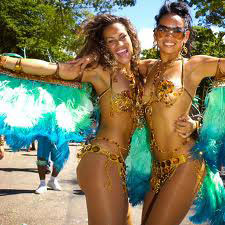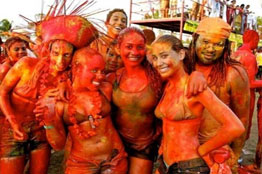by Melanie Reffes
New soca tunes are hitting the airwaves. There's a run on glitter and feathers in local shops.
Suddenly, the gyms are packed as Caribbean island residents tone their bodies for the big day.
What's going on? Carnival, baby!
The tradition started centuries ago when Italian Catholics hosted costumed balls before the first day of Lent. As meat eating was not allowed during the holiday, they called the festival "carnevale" which means "put away the meat." From steel pan and jump-ups to pageants and parades, Carnival celebrations in the Caribbean are the greatest parties under the tropical sun.
The tradition was picked up in the States where wealthy plantation owners hosted grand Carnivals in their homes while their slaves held smaller ones in the backyard. After slavery was abolished, Carnival took to the streets, honoring the African tradition of parading through villages sporting costumes and masks fashioned from feathers and fabric and decorated with bone, bead and shell. Aimed not only at bringing good fortune to the revelers, these flashy fetes also appeased angry relatives who had passed into the next world. Today, nearly every country in the Caribbean hosts a cultural kaleidoscope of high-octane dance, raucous street jams and fantastical pageantry.
Hugh Riley, secretary-general of the Caribbean Tourism Organization, has some advice for Carnival-bound travelers: "Be warned that Caribbean music is highly infectious and can lead your body ... to move muscles one wouldn't normally use in daily life."
Many of the Carnival dates are based on the Lenten calendar, so they change every year. But Carnival isn't strictly pegged to the Lenten calendar – the concept is so popular that Carnival occurs throughout the year on various islands. Below are the island-by-island details to help you plan your clients' next Carnival vacation.
Trinidad & Tobago
Nothing comes close to Port au Spain come Carnival week. Heralded as the best party on earth, Trinidad Carnival (March 5-8) is the granddaddy of them all, attracting hard-core fans from across the globe who book air tickets and hotel rooms six months in advance. During the days leading up to Carnival, Port au Spain is immersed in soca and steel pan music as the whole island catches Carnival fever. Mas or masquerade steel pan concerts, flamboyantly risqué costumes that can reach thirty feet high and take months to create, and revelers slathered in everything from oil and grease to chocolate and mud are the sacred hallmarks of Carnival Monday and Tuesday (March 7-8, 2011).
Instead of being on the sidelines watching, with a little bit of advance planning you can join one of the Carnival masquerade groups (called "bands"). You'll dance for hours through the city streets with a music truck in front of you and a rum truck right behind. The fee for joining a band varies – the lowest is $500. This buys a costume, food and libations for two full days of reckless abandon. Selecting a band with a theme that suits your style is paramount. Options include "Way of the Warrior" for the Tribe band, which is the largest with more than 4,000 people signing up each year (www.carnivaltribe.com) and the "Planet Rock" theme for the Harts band (www.hartscarnival.com).
The moment Carnival stops, everyone hits the Trinidad & Tobago beaches for a "cool down" period.
www.goTrinidadandTobago.com
The Bahamas
As Bahamian as a warm breeze and a chilled Goombay Smash, Junkanoo is all about banging goat skin drums, tooting brass horns, clanging cowbells and crowding onto rooftops for views of the parade. It starts with a shotgun blast at midnight on Dec. 26 and again on New Years Day as the Junkanoo winds its way through the streets of Nassau. Festivities are also held in the Out Islands.
Depending on who you ask, "Junkanoo" refers either to John Canoe, an African tribal chief or the French term "l'inconn" meaning "unknown people." referring to the ornate masks that are parade trademarks.
New on the waterfront in Nassau, a museum that showcases Junkanoo costumes is open daily from 10 a.m. to 4 p.m.
"Junkanoo is an exciting way of becoming intimately acquainted with what it means to be Bahamian," says Sen. Vincent Vanderpool-Wallace, minister of tourism. "It is truly one of the great performance art traditions of our country."
www.bahamas.com

Jamaica
Starting on Feb. 18 and continuing through May 1, Bacchanal heats up Jamaica with road marches through the streets of Kingston and on the Hip Strip in Montego Bay. Although it's mostly a local affair, tourists are welcome for all events like Bacchanal Fridays, Beach J'ouvert on April 23, Soca at De Sandbar on April 27 and Bacchanal J'ouvert on April 29.
www.bacchanaljamaica.com
USVI
"I've been participating (in Carnival) since I was 8 years old," remembers Chantal Figueroa, deputy commissioner, department of tourism, "During the month-long celebration, we eat traditional dishes to delight our bellies and then wash it all down with old time drinks."
Three islands and three carnivals rock the U.S. Virgin Islands with the Crucian Christmas festival in St. Croix leading the pack now through Jan. 8. The largest Carnival in the trio rocks St. Thomas in April. In St. John, the family-friendly Carnival is on July 4.
In St. Croix, food, crafts and music are mainstays while the j'ouvert is the fan favorite.
www.stxfestival.com |